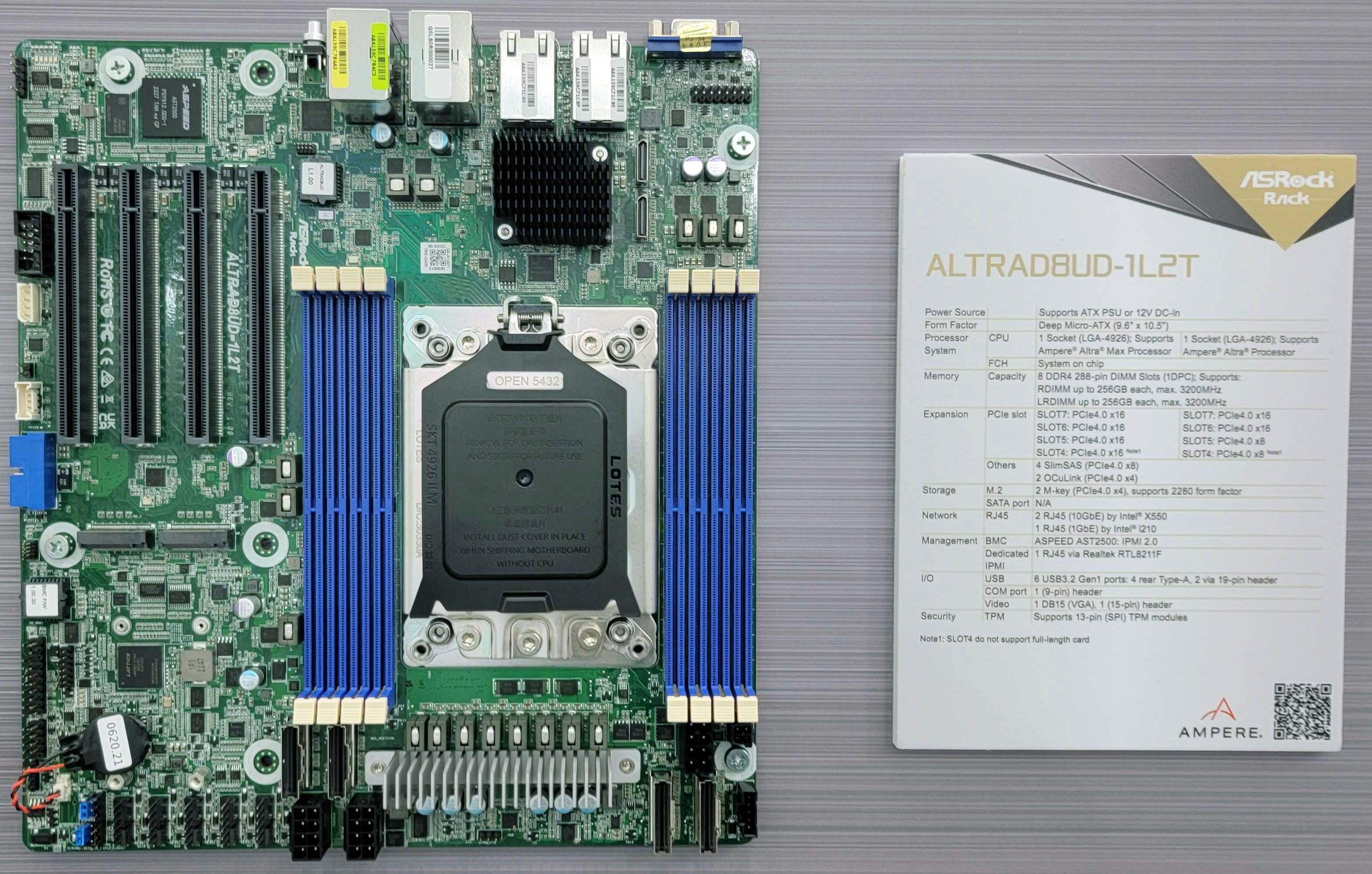ASRock Goes Ampere: Up to 128 Arm Cores in Deep MicroATX

ASRock Rack has showcased its first motherboard for Ampere's Altra and Altra Max processors marking its entrance into the Arm-based servers business. The company's ALTRAD8UD-1L2T demonstrated at Computex can be used to build miniature servers or workstations featuring up to 128 Armv8 cores and datacenter-grade expandability and manageability.
ASRock Rack's ALTRAD8UD-1L2T fully supports Ampere's Altra and Altra Max CPUs with 32 – 128 cores that can be paired with up to 2TB of memory using eight DDR4-3200 modules. In addition, the motherboard takes advantage of rather abundant I/O capabilities that Ampere's 1st Generation Altra Max datacenter SoCs have, including 128 PCIe Gen4 lanes with down to x2 and x4 bifurcation.
Regarding physical slots, the motherboard has four PCIe x16 slots, two M.2-2280 slots, four SlimSAS connectors, and two OCuLink connectors for SSDs. The platform also has two 10GbE ports controlled by the Intel X550, one GbE connector enabled by the Intel I210, and one GbE driven by the Realtek RTL8211F for remote management supported by the Aspeed AST2500 BMC. The motherboard also has an SPI connector for TPM modules, USB 3.2 Gen1 ports, and a D-Sub VGA display connector.

One of the peculiarities of the ASRock ALTRAD8UD-1L2T platform is that it comes in the company's proprietary Deep microATX form factor, which will prevent it from installing into regular microATX chassis. In fact, we don't even know if it can be mounted into standard ATX or Full ATX towers. Yet, ASRock Rack will probably offer a chassis to install such motherboards into racks or desktop environments.
One of the questions about the ALTRAD8UD-1L2T is its target market. Ampere's Altra and Altra Max processors are tailored for cloud workloads, so using them as client machines hardly makes any sense for anything other than cloud software development. Yet, ASRock certainly sees that the market of microATX-ish platforms for Ampere CPUs is promising enough to address it.
ASRock Rack is the sixth company to offer a platform based on Ampere Altra processors after Foxconn, Gigabyte, HPE, Supermicro, and Wiwynn.
Get Tom's Hardware's best news and in-depth reviews, straight to your inbox.

Anton Shilov is a contributing writer at Tom’s Hardware. Over the past couple of decades, he has covered everything from CPUs and GPUs to supercomputers and from modern process technologies and latest fab tools to high-tech industry trends.
- Paul AlcornEditor-in-Chief
-
BillyBuerger ReplyOne of the peculiarities of the ASRock ALTRAD8UD-1L2T platform is that it comes in the company's proprietary Deep microATX form factor, which will prevent it from installing into regular microATX chassis. In fact, we don't even know if it can be mounted into standard ATX or Full ATX towers. Yet, ASRock Rack will probably offer a chassis to install such motherboards into racks or desktop environments.
The mounting holes all seem to match up with microATX other than the fact that the CPU/memory block two of the mounting points. It only sticks out a little bit farther forward past the widest mounting holes. So it would seem it should fit in most mATX cases.
I personally really like the overall layout. The VRMs and such are in the front meaning the standard power (12VO in this case it seems) and the CPU power are all in the same location right in the front. And while the M.2 slots are still under the GPU, having them in front of the slots is better then in between them. It would be nice to see more options for motherboard layout. Seems most of them all do it the same. Seeing anything different gets my attention. -
bit_user Altra is really beginning to feel quite dated, by this point. Yet, it's definitely cool to be able to build your own (up to) 128-core ARM server!Reply
I am currently waiting to buy a Rockchip RK3588 SBC, which is at least 2x as fast as a Pi v4 and uses a combination of 4x A76 + 4x A55 cores. The Altra CPUs have a sever version of the A76, so that really puts it into some perspective.
In terms of server hardware, I just bought my second ASRockRack motherboard. So far, I've been satisfied (sadly, I can't say that 100% for their consumer boards). -
domih Reply
I'm using a Radxa Rock 5B. I'm running Linux Armbian. Yes, it is quite fast compared to the previous generation (Rock 4B with Rockship RK3399). I'm also using ODROID's (XU-4, H2C, M1, H2+, H3, H3+). I don't care much about the Pi 4.bit_user said:Altra is really beginning to feel quite dated, by this point. Yet, it's definitely cool to be able to build your own (up to) 128-core ARM server!
I am currently waiting to buy a Rockchip RK3588 SBC, which is at least 2x as fast as a Pi v4 and uses a combination of 4x A76 + 4x A55 cores. The Altra CPUs have a sever version of the A76, so that really puts it into some perspective.
In terms of server hardware, I just bought by second ASRockRack motherboard. So far, I've been satisfied (sadly, I can't say that 100% for their consumer boards). -
domih One would love to "play" with this motherboard. But I'm not sure if it will go details. Mobo +CPU + etc will probably be around 8K. Ah! Plus Ampere Altra is still extremely rare on eBay, maybe in a few years...Reply